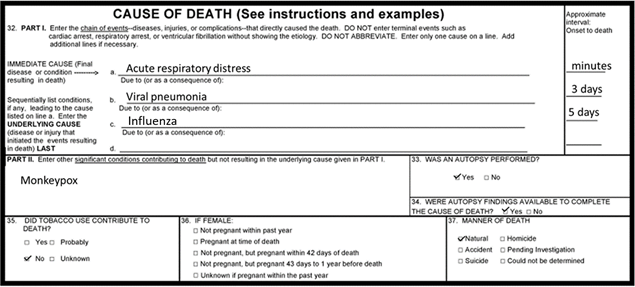Key points
- Mortality surveillance provides crucial information about fatal outcomes at the population-level, which can guide public health action.
- Monitoring causes of death reported on death certificates is one of the most important methods of mortality surveillance.
- Where possible, specify a logical causal pathway leading to death in Part I of the death certificate.
Overview
Monkeypox can cause severe complications and can lead to prolonged illness, hospitalization and, in rare cases, death. Such outcomes are most often seen among those who are immunocompromised or who have other pre-existing illnesses or conditions. Specifically, people with advanced HIV infection have been more likely to develop severe illness with monkeypox and die from the disease. This has been observed in both the ongoing global clade II outbreak affecting the United States and in past clade I and clade II monkeypox outbreaks in central and western Africa.
Mortality surveillance provides crucial information about fatal outcomes at the population-level, which can guide public health action. One of the most important methods of mortality surveillance is monitoring causes of death reported on death certificates.
Monkeypox reporting on the death certificate for all decedents where the disease caused or contributed to death is important to ensure deaths related to monkeypox are captured. Where possible, it is important to specify a logical causal pathway leading to death in Part I of the death certificate. Monkeypox should not be reported on the death certificate if it did not cause or contribute to the death.
When to report monkeypox on the death certificate
Examples of how to determine if monkeypox reporting on a death certificate is warranted include the following:
- Where monkeypox causes fatal complications, such as sepsis or pneumonia, these complications would be included along with monkeypox in Part I in a logical, causal order.
- Where monkeypox was a significant contributing factor leading to death, but not part of the causal pathway, it would be reported in Part II.
- If monkeypox was an incidental factor, i.e., did not contribute to death, it would not be reported on the death certificate.
Including as many details as possible based on knowledge of the case, medical records, laboratory testing, and autopsy findings is ideal. For additional information, please see the following:
Example death certificates
Below are two examples of sample death certificates. Example 1 shows a death in which monkeypox is reported as the underlying cause. Example 2 shows a death in which monkeypox is reported as a contributing factor.


Additional resources
Death certificates may be helpful in defining whether monkeypox is causal or may have contributed to a death. Death certificate reporting may not meet mandatory reporting requirements for reportable diseases in all jurisdictions; contact the appropriate health department regarding regulations specific to the jurisdiction.
For a more general guidance and training on cause-of-death reporting, certifiers can refer to the Cause of Death mobile app and the Improving Cause of Death Reporting online training module.
Users may also refer to the Autopsy and Handling of Human Remains of Patients with Monkeypox. Monkeypox-related deaths in new or previously reported cases are reportable to CDC by public health authorities via DCIPHER (Data Collation and Integration for Public Health Event Responses), and/or National Notifiable Diseases Surveillance System according to the Generic Version 2 Message Mapping Guide and are reported on the CDC website.
